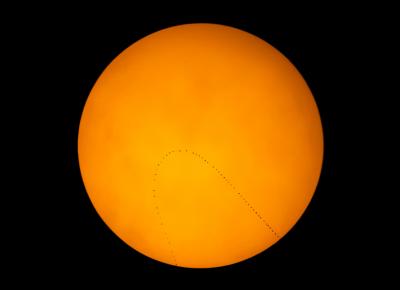Transit image with a twist (and a turn!)

Credit: NSF’s National Optical-Infrared Astronomy Research Laboratory
About 13 times per century, fleeting Mercury can be seen passing directly in front of the Sun in what is called a transit. The most recent Mercury transit occurred on 11 November 11, 2019.
Teams on Cerro Tololo Inter-American Observatory (CTIO) and Kitt Peak National Observatory (KPNO) developed observing plans in an effort to recreate an experiment to calculate the Earth-Sun distance. CTIO’s Daniel Munizaga obtained this image of the transit with a 6-inch Celestron Nexstar telescope and a Nikon D750 camera by taking images every five minutes. While the path of Mercury across the Sun in fact traced a straight line, in this image the path appears to loop backwards owingdue to an effect called field rotation as the telescope and camera track across the sky.
Juan Seguel also imaged the transit of Mercury from CTIO, accompanied by students from the Universidad de La Serena. They imaged the transit with an 11-inch Nexstar telescope and ZWO 1600MM Pro camera equipped with a Fastar system. Simultaneously, Rob Sparks led a team of students from Ha:san Preparatory and Leadership School imaging the transit on Kitt Peak with an 8-inch Nexstar telescope and Canon 6d camera. Kitt Peak suffereddealt with clouds and could only image part of the transit.
The goal of having two widely separated teams imaging the transit is to recreate the historic measurement of the distance from the Earth to the Sun. Mercury will appear in slightly different positions on the Sun owingdue to parallax. By carefully measuring the difference in Mercury’s position, and knowing how far apart the observers were, the distance to the Sun can be calculated.
Teams will not have another opportunity to attempt this observation until the next transit of Mercury on 14 November 14, 2032.
###
Media Contact
Peter Michaud
[email protected]
808-974-2510
Original Source
https:/




